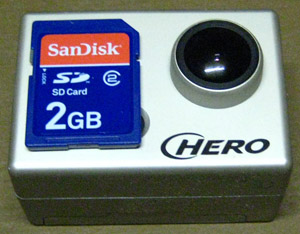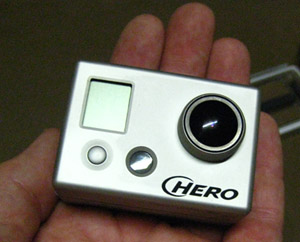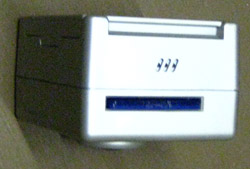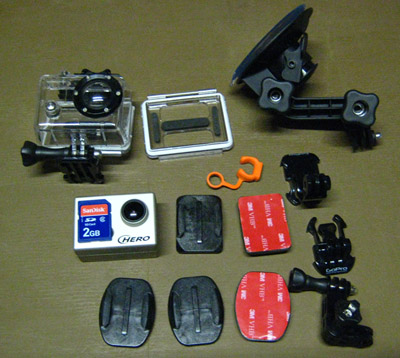GoPro HD Hero Wide
Apparently I was a good boy last year, so Santa brought me a GoPro Motorsports HD Wide Hero, and a helmet mount. Mine was supplied by WA based Launch Helmet Cams, who scored the business after I talked to them at the Sydney Motorcycle Show. I expected the camera would be great on the moto, in the car, and when I’m out hitting the mtb trails.
In fact, it’s been amazing.
This tiny device can record in SD, HD 720p (30 frames per second), HD 720p (60 fps), HD 960p (30 fps), and finally, HD 1080p (30 fps). On top of that, the case is waterproof. Rain is not going to be a problem.
Dimensions
According to GoPro, the HD weighs 167g including housing, but you'll need to add mounts to that total. Although the camera’s light, it's noticeable on my bicycle helmet, highlighting the need for a bit more padding in the forehead area. I think it would be better on my old helmet, which had a more comfortable band. It's not an unbearable weight, just noticeable.
I measure the housing at 69mm at the widest, 43 mm deep (including the on/off button), and 64 mm tall (including top latch, not including mount).
 card shown for scale purposes, not included in kit |
 hand shown for scale purposes, not included in kit... |
Waterproof
GoPro claim the HD Hero housing is waterproof to an amazing 60m, with the caveat that the seal must be absolutely clean – no dirt, hair, or anything which could prevent a full seal. I’ve stuck mine into a small waterfall, surfed, swum, and ridden in light rain, and it hs been fine. Not much of a depth test, but I’m not likely to find myself 60m below the surface very often. 60m gives me plenty of safety margin for surf and snorkelling/scuba diving, and, even at speed, heavy rain will be no problem.
Ease of use
Two buttons, a small LCD display, and a flashing LED. That's the sum total of the controls. The front button turns the camera on, and switches between modes. The top button takes shots and allows access to menus. I needed the manual until I learned the sequence - but it didn't take long.
I set the camera to start in video mode, so I turn it on (push front button) and start recording (push top button). That's it - too easy. When done, top button to stop recording, and front button to turn it off. The case includes external waterproof buttons, no need to open and shut it.
Video output
HD 720p (1280x720), and full-HD 1080p (1920x1080). Need I say more? Well, yes. I should also say 60fps, available in 720p and WVGA (848x480) modes and allowing clearer slo-mo. Finally, there's a tall mode - 960p (1280x960) in 4:3 (the rest are 16:9).
I’ve seen the output of some other brands on the web, and frankly there’s no comparison. Unlike similarly priced units, the GoPro suffers very little of that “wobbly jelly” effect seen in bumpy conditions, and its wide angle means you don’t miss much – as long as it’s not too far away. HD ensures a bright, sharp picture, slightly oversaturated with colour. Sure, it may not compare with Blu-Ray, but it's a huge improvement over my old setup (bullet camera on helmet, big video camera in back pack, wires everywhere) and other output I've seen online. If you have a look in GoPro's video gallery you'll see some really good footage. The surf footage, in particular, is amazing.
It's not so great at low light, and prefers bright sunny days for the sharpest pictures. Low light gets very grainy before disappearing as it gets darker. I can still see (just), but the camera can't. The aperture changes automatically, but when you go from heavy shade to bright light there is a brief delay before the camera reacts.
GoPro videos can be played by connecting it directly to your TV – USB, HD (component) or AV. Alternatively connect to your PC via USB. On the PC, I initially had to use QuickTime to view the files; Media Player wouldn’t work without additional codecs. I've since upgraded to Windows 7 and made certain I had the latest codecs - MediaPlayer 11 now plays raw GoPro files.
I couldn’t upload directly to YouTube as it didn’t like the GoPro format, but had no problem with uploading to Vimeo, so maybe it was user error. I’ve used Any Video Converter to convert the MP4 output to ...ummm… MP4... for upload to YouTube. AVC also allows me to cut the boring bits at the start and finish of each clip – no-one wants to look up my nose as I check the front LCD display to be sure it’s recording. Conversion is also required so the video will be recognised by even recent editing software, such as Corel Visual Studio, but the situation is changing. Adobe Premier Elements and AVS Video Editor will accept GoPro files natively.
Watching on a big screen TV is just like being there - I've relived several rides over and over.
You can see some edited examples at my Youtube channel (watch in HD if possible - even though YouTube only goes up to 720p).
Photo output
The HD takes 5mp still shots, singly, timed singles, three shots in a row, or a single photo every 2/5/10/30/60 seconds until the battery expires, or you fill the card.
Recording times
Average recording times are quoted as:
| 1080p | 12 min/GB |
| 960p | 13 min/GB |
| 720p (60fps) | 11 min/GB |
| 720p (30 fps) | 16 min/GB |
Sound
 the GoPro mic |
GoPro provide an additional open or vented door for the case, which is claimed to reduce wind noise up to 160 kmh. Because the door is vented, the case is no longer water or dust proof. I haven’t used this yet, as we’ve had few weeks of storms and the threat of storms, so I haven’t taken any chances. Wettest. Holidays. Ever. |
Wind noise is there, but it’s not excessive. What is noisy is the mount connection – some creaking – and low hanging shrubbery. If I'm wearing my mp3 player and using the chest mount, there is lots of clattering and rattling as the earphone cable hits the case. Little brushes you barely hear while riding are amplified out of all proportion in playback. It makes sense, as the hits are directly on the case. It just means you need to be careful to avoid things hitting the GoPro case.
I reckon my voice isn’t recorded well, though – I’ve tried to give some commentary while riding, and it’s been a dismal, muffled failure. I’ll wait till I use the open back before marking them down on this one - at least you can't hear my heart race or breath wheezing. Rattles from my bike seem to come across loudly enough. Unlike the older SD model, there's no Hi or Low sound recording modes.
Mounts
GoPro provide a wealth of specialised mounts for bicycles, cars, motorbikes, heads, chests and tripods, flat and curved surfaces (stick-on).
Choose an appropriate pivot clip and bolt it to the case with the supplied long bolt. The other end is the spring clip which slides into the helmet, chesty, flat or curved mount. The clip slides into the mount in two directions. Once in, it isn't going to come apart, but it's not always as tight as I’d like. There's wiggle room between the clip and helmet mount, but I’ve packed it with paper for a solid, but still removable connection. The chesty seems to have less wiggle room.
After fixing the wiggle problem, I finally discovered just what the hell the orange doohickey does. It fits into the mount clip to fix the slop. GoPro had already thought of a fix. I just wish they’d mentioned it in the “manual”.
With all the bits and pieces I have, I've got some risers/direction changers, which are less useful than they seem. Once you connect a couple together, the weight of the camera tends to move it to a new position over the first bump. I put mine on the seat post looking back, and got some great rear facing footage, went over a bump and got some great footage of the rear tyre... Maybe if I scuff them up a little.
The helmet and chest mounts give a nice stable picture, while the rigid mounts bounce and vibrate a lot off road (they're OK at lower speeds or smooth surfaces). The suction mount is a bit of a mix - it bounces and vibrates more than the chest and helmet mounts, but its design means that some of the movement is damped by the suction cup. It's good on road, but I'm not sure how it would go when 4WDing or dirt bike riding. The suction cup won't work on my pushbikes as there aren't any large enough flat surfaces to stick on - great on motorbike tanks/fairings or cars, though.
What’s in the box?
As mentioned above, I bought the Motorsports version - other versions have different inclusions.
top row |
middle row |
bottom row |
| Waterproof case & short clip | Camera | Stick on flat mounts x 3 |
| Extra case door (vented) | Stick on curved mounts x 2 | Three way pivoting arm |
| Suction mount | Orange doohickey | |
| Long (J) and short clips | ||
not shown |
||
| Manual | RCA/Component video/audio cables | USB cable |

SD card not included, cables and manual not shown
Extras I’ve bought
| Vented helmet strap | Bike mount (inc bolts and riser) | Spare battery |
| Chesty mount | Tripod mount | Bigger SD card |
Expansion
Apart from all the mounts, the HD has an expansion port on the rear of the camera. This port will allow Bakpacs (tm) to be added as they are released. Planned Bakpacs are an LCD display and a battery expander. No doubt a larger case will be required if you use a Bakpac, and the weight will go up, which may be a problem on bike helmets. |
 rear view, showing expansion port and battery cover (listing available resolutions) |
Charging
Charging is easy – use the supplied USB cable to plug the camera into an active USB port, and wait till the light goes out. Alternatively, use a USB charger (not supplied). Charging to 80% takes two hours via USB, or one hour with the optional charger.
Problems
I've had three problems, one was fixed under warranty, and I've solved the others.
The latch that holds the cover shut broke. It had always creaked as I opened or closed the camera, but this day it just snapped. Not, when I was locking the case, as you’d expect, but when I opened it. No noise, no feeling, just no longer in one piece. However, I called Launch, who said snapping this clip was very rare, and they happily replaced the broken part under warranty. The new latch works a treat. Score one for Launch and GoPro!
Recording has inexplicably cut out a few times, which has been very annoying. Forum research reveals it seems to be to do with the SD card. GoPro cards format as FAT32, which has a maximum file size of ~4GB. GoPro gets around this by stopping recording just before the limit, and automatically restarting a new file, and so on, until the card is full. In theory, you'd lose no more than a few seconds per session. Apparently, some cards don't restart automatically. My card - MaxFlash 16GB class 6 (and bought from Launch). restarts automatically, but cuts out after another six minutes or so. Totally crap.
On the forums, some users have the problem, some don't, and the difference appears to be the card they use, although a lot are pinning their hopes on a firmware upgrade - no idea when that's due, it's been "coming soon" since before Christmas 2009. I emailed GoPro, and they claim that Kingston (class 4) cards work. You'd think a class 6 (faster) would be better than a class 4. However, I've ordered a Kingston, so we'll see what happens. I can always use the other one in my still camera. I'll update on this problem later. Update: New Kingston card and no more problem. I don't know if the firmware update has looked at this issue, and now it works, don't care. ;^)
The other problem is a bit more complex. Fogging. Apparently, fogging is a common problem with sealed dive cameras. The GoPro is sealed for watertightness, which means that whatever moisture laden air is trapped inside stays inside. As outside temperatures change (say when you're rapidly descending/ascending or going underwater), or as the camera heats up, condensation forms inside the case. Guess where it deposits. Yup, on the camera lens. Well, it probably deposits elsewhere, but it's the stuff on the lens that is the problem. You usually can't see fogging in use, so it's only when you get home to eagerly review your footage that disappointment sets in.
Fogging only happens sometimes, but when you lose good footage it's annoying. Forums suggest drilling holes in the back of the case, but the HD comes with a separate back that is already open. Obviously, you lose all waterproofing if you drill or use the open back, and forget about warranty if you start waving drills about. Another idea is to fill the case full of dehumidified air-con air (from your car, for example) before sealing. Alternatively, put sachets of silica gel into the sealed case.
I've been trying silica gel, but getting sachets small enough to fit is a problem - I have to open the sachets I bought and tip about half out before resealing them. I have 2 gm sachets of silica gel, and would like to try 1 gm. Silica gel works. No fogging when there's a fresh sachet in there, but I didn't get the stuff that changes colour when it's waterlogged, so I can't tell if it's still OK or not. Best to store sachets carefully and always put a new one in before use.
Recognising the problem, GoPro now sell re-usable AntiFog inserts that slide into the sides of the housing. I'm guessing that these are some sort of silica gel designed to fit.
Editing Software
No software comes with the GoPro HD Hero.
It seems that software that natively accepts GoPro's mp4 output is still thin on the ground. I was using Any Video Converter to convert it into a format compatible with my editing software.
I tried AVS Video Editor 4 (crippled with a small notice in the centre of the first minute's output), and was all set to buy it - it's fairly simple to use, and seems to have most, if not all of the features I want - although I'm still trying to find a decent crossfade. AVS accepts GoPro output without conversion and outputs up to 1080p - not all programs can match that. The price is reasonable, especially with a big discount at the time of writing, and includes access to all AVS products. However, I've since discovered that my 1080p input to 1080p output has issues - output so far is stuttery. 720p to 720p seems to be OK. I've emailed support. My PC seems fast enough - it plays the raw files just fine.
Early on, I tried a couple of freeware programs, but I didn't like them and didn't persist. Others may swear by them, I just found them hard to use. I won't single any out, because it may just have been the learning curve and something about old dogs and new tricks.
In the end, I bought Pinnacle Systems HD Studio. It works, but crashes with some filter combinations (slo-mo + stabilise causes issues, for example). Retail price in Australia is stupid, and we can't pay to download from the US (much, much cheaper) without a US postal address. Working at a uni, I qualified for the educational price, which brought it back down to US retail.
Support
My warranty experience with Launch has been good, and the original order was delivered promptly, as were subsequent orders (next day).
Firmware Update
In September 2010, a long awaited firmware update was released (free), which includes support for upside down recording. This feature is great for when I'm wearing the chest mount on the bike, and I mount the camera upside down to get the right angle - no need to flip the video in software. Another new feature is one button on. You can preset a default power on mode and one button mode, and the GoPro will start recording in that mode as soon as you push either button. Even easier to use! There's also Live Feed out and PAL support. Well worth the download.
Summary
For its intended purposes, the GoPro HD Hero is a brilliant little camera. I’m very impressed. It may not have the bells and whistles of a regular camcorder, but you don’t miss them, and if you added them it would be big, bulky, fragile, and a lot more expensive - none of which you want in a wearable camera. If I can overcome the card issue, and with silica gel, this camera will be almost perfect.
Pros
- It’s tiny
- Full HD (up to 1920 x 1080)
- 170 degree field of vision (720p) - 127 degree field of vision for 1080p
- Takes commonly available SD/SDHC cards, up to 32 GB (faster cards are better)
- Lots of mounts available for different purposes – bikes, cars, surfboarding
- It's simple - there are only two buttons
- 5 MP photo options
- excellent output
Cons
- Fogging
- Software capable of editing H.264 output in MP4 is still thin on the ground.
- No LCD display – coming as a Bakpac (tm). You won't know if you have the camera in the right position, or fogged, until you get onto a computer.
- No zoom
- Operator error has been a problem a couple of times...
- I reckon the mounts connect a bit loosely, probably allowing some unwanted vibration. The orange doohickey helps fix this.
- Possibly fragile plastic latch.
- The name's more than a bit wanky - Hero?
![]()



4 fat hippies
